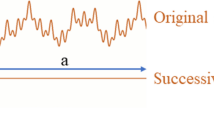Abstract
As the key technique of improved Hilbert-Huang transform (HHT), ensemble empirical mode decomposition (EEMD) has a good performance of eliminating mode mixing phenomenon, which has a strong impact on the observation of seismic information. However, the intrinsic mode functions (IMF) obtained from EEMD contain noises, so that it is required to find a more robust frequency estimation method to calculate the instantaneous frequency (IF) of IMF. For this reason, the improved HHT algorithm based on the damped instantaneous frequency (DIF) is proposed to overcome the shortage of EEMD. Compared with other IF estimation methods, the DIF has strong antinoise ability and high estimation accuracy. The test results of synthetic and real seismic data show that the proposed algorithm is feasible and effective for extracting seismic instantaneous attributes.
Similar content being viewed by others
References Cited
Battista, B. M., Knapp, C., Mc Gee, T., et al., 2007. Application of the Empirical Mode Decomposition and Hilbert-Huang Transform to Seismic Reflection Data. Geophysics. 72(2): H29–H37. doi:10.1190/1.2437700
Boashash, B., 1992. Estimating and Interpreting the Instantaneous Frequency of a Signal. II. Algorithms and Applications. Proceedings of the IEEE. 80(4): 540–568. doi:10.1109/5.135378
Chen, C. S., Jeng, Y., 2011. Nonlinear Data Processing Method for the Signal Enhancement of GPR Data. Journal of Applied Geophysics. 75(1): 113–123. doi:10.1016/j.jappgeo.2011.06.017
Chen, C. S., Jeng, Y., 2013. Natural Logarithm Transformed EEMD Instantaneous Attributes of Reflection Data. Journal of Applied Geophysics. 95: 53–65. doi:10.1016/j.jappgeo.2013.05.006
Chen, L., Song, H. B., 2009. The Estimation of Instantaneous Frequency of Seismic Signal. Chinese Journal of Geophysics, 52(1): 206–214 (in Chinese with English Abstract)
Chen, Y. P., Peng, Z. M., He, Z. H., et al., 2013. The Optimal Fractional Gabor Transform Based on the Adaptive Window Function and Its Application. Applied Geophysics. 10(3): 305–313. doi:10.1007/s11770-013-0392-2
Cohen, L., 1995. Time-Frequency Analysis: Theory and Applications. Prentice Hall, New York
Deering, R., Kaiser, J. F., 2005. The Use of a Masking Signal to Improve Empirical Mode Decomposition. IEEE, ICASSP. 485–488
Flandrin, P., Rilling, G., Goncalves, P., 2004. Empirical Mode Decomposition as a Filter Bank. IEEE Signal Processing Letters. 11(2): 112–114. doi:10.1109/lsp.2003.821662
Han, J. J., van der Baan, M. V. D., 2013. Empirical Mode Decomposition for Seismic Time-Frequency Analysis. Geophysics. 78(2): O9–O19. doi:10.1190/geo2012-0199.1
Huang, N. E., Shen Z., Long, S. R., 1999. A New View of Nonlinear Water Waves: The Hilbert Spectrum 1. Annual Review of Fluid Mechanics. 31(1): 417–457. doi:10.1146/annurev.fluid.31.1.417
Huang, N. E., Shen, Z., Long, S. R., et al., 1998. The Empirical Mode Decomposition and the Hilbert Spectrum for Nonlinear and Non-Stationary Time Series Analysis. Proceedings of the Royal Society A: Mathematical, Physical and Engineering Sciences. 454(1971): 903–995. doi:10.1098/rspa.1998.0193
Huang, N. E., Wu, M. L. C., Long, S. R., et al., 2003. A Confidence Limit for the Empirical Mode Decomposition and Hilbert Spectral Analysis. Proceedings of the Royal Society A: Mathematical, Physical and Engineering Sciences. 459(2037): 2317–2345. doi:10.1098/rspa.2003.1123
Huang, Y. P., Geng, J. H., Zhong, G. F., et al., 2011. Seismic Attribute Extraction Based on HHT and Its Application in a Marine Carbonate Area. Applied Geophysics. 8(2): 125–133. doi:10.1007/s11770-010-0279-z
Li, G. H., 2012. The Research and Application of Signal Analysis Based on HHT and Its Improved Method: [Dissertation]. Chengdu University of Technology, Chengdu (in Chinese with English Abstract)
Liu, Y. P., Li, Y., Lin, H. B., et al., 2014. An Amplitude-Preserved Time-Frequency Peak Filtering Based on Empirical Mode Decomposition for Seismic Random Noise Reduction. IEEE Geoscience and Remote Sensing Letters. 11(5): 896–900. doi:10.1109/lgrs.2013.2281202
Shi, H., Li, G. L., Wang, W., et al., 2011. Random Noise Attenuation Based on Ensemble Empirical Mode Decomposition. Progress in Geophysics, 26(1): 71–78 (in Chinese with English Abstract)
Song, H. B., Bai, Y., Pinheiro, L., et al., 2012. Analysis of Ocean Internal Waves Imaged by Multichannel Reflection Seismics, Using Ensemble Empirical Mode Decomposition. Journal of Geophysics and Engineering. 9(3): 302–311. doi:10.1088/1742-2132/9/3/302
Tian, L., Peng, Z. M., 2014. Determining the Optimal Order of Fractional Gabor Transform Based on Kurtosis Maximization and Its Application. Journal of Applied Geophysics. 108: 152–158. doi:10.1016/j.jappgeo.2014.06.009
Wang, T., Zhang, M. C., Yu, Q. H., et al., 2012. Comparing the Applications of EMD and EEMD on Time-Frequency Analysis of Seismic Signal. Journal of Applied Geophysics. 83: 29–34. doi:10.1016/j.jappgeo.2012.05.002
Wu, A. X., 2012. HHT Time-Frequency Analysis of Digital Seismic Waveform Signals. FSKD, 9: 1802–1806
Wu, Z. H., Huang, N. E., 2009. Ensemble Empirical Mode Decomposition: A Noise-Assisted Data Analysis Method. Advances in Adaptive Data Analysis. 1(1): 1–41. doi:10.1142/s1793536909000047
Wu, Z., Huang, N. E., 2004. A Study of the Characteristics of White Noise Using the Empirical Mode Decomposition Method. Proceedings of the Royal Society A: Mathematical, Physical and Engineering Sciences. 460(2046): 1597–1611. doi:10.1098/rspa.2003.1221
Zhao, C. X., 2011. The Research of Time-Frequency Analysis Method Based on Hilbert-Huang Transform: [Dissertation]. China University of Petroleum, Beijing (in Chinese with English Abstract)
Zhou, Y. H., Chen, W. C., Gao, J. H., et al., 2012. Application of Hilbert-Huang Transform Based Instantaneous Frequency to Seismic Reflection Data. Journal of Applied Geophysics. 82: 68–74. doi:10.1016/j.jappgeo.2012.04.002
Author information
Authors and Affiliations
Corresponding author
Rights and permissions
About this article
Cite this article
Wang, Y., Peng, Z. & He, Y. Instantaneous attributes analysis of seismic signals using improved HHT. J. Earth Sci. 26, 515–521 (2015). https://doi.org/10.1007/s12583-015-0555-6
Received:
Accepted:
Published:
Issue Date:
DOI: https://doi.org/10.1007/s12583-015-0555-6




